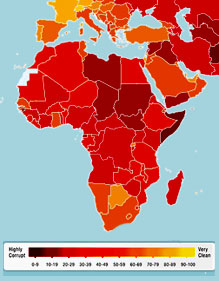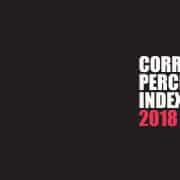|
Getting your Trinity Audio player ready...
|
 Transparency International’s (TI) 20th Corruption Perceptions Index (CPI) will be released on 3 December. This year's index ranks 175 countries or territories by their perceived levels of public sector corruption. The lower the score, which falls between 100 and 0, the more corrupt the country is perceived to be.
Transparency International’s (TI) 20th Corruption Perceptions Index (CPI) will be released on 3 December. This year's index ranks 175 countries or territories by their perceived levels of public sector corruption. The lower the score, which falls between 100 and 0, the more corrupt the country is perceived to be.
In 2013 South Africa did not improve noticeably on its score of 43 and ranking of 69 for 2012. In the last two years the country has dropped three places on the sub-Saharan Africa rankings, from seven to 10.
In the 2013 global context South Africa was ranked joint 72nd with an unexceptional score of 42, meaning that it’s perceived to be somewhat more corrupt than not. The global average was 43, with 70% of the 177 countries assessed in 2013 scoring below 50.
The country’s almost unchanged index scores were likely the result of outrage expressed by the public in the form of service delivery protests, and eagerness to report corruption to independent civil society-based organisations like Corruption Watch. The mediocre score could also be indicative of the public's growing intolerance of the abuse of public resources and dwindling trust in political, public, and business leadership.
Will South Africa manage to do better than the global average this year? Watch this space on 3 December to find out.
Perceptions of corruption is just one way of assessing the problem
The CPI is compiled from the results of 12 surveys and assessments that feature expert evaluations and the views of businesspeople, gathered in the past 24 months. The surveys are collected by a variety of reputable institutions which specialise in scrutinising governance and the business climate. It offers a yearly snapshot of the relative degree of corruption by ranking countries from all over the globe.
The CPI is based on perceptions, explains TI, because there is no sound and meaningful way to establish absolute levels of corruption. Much of the illegal practice takes place in secret and while much of it is exposed, there is a lot that never comes to light. “Capturing perceptions of corruption of those in a position to offer assessments of public sector corruption is the most reliable method of comparing relative corruption levels across countries,” says TI.
As the CPI is based solely on perceptions of corruption in the public sector, TI offers a range of other complementary tools which provide alternative views on corruption. They include the Bribe Payers Index, the Global Corruption Barometer, the Global Corruption Report, the National Integrity System assessments, and the Transparency in Corporate Reporting study.






